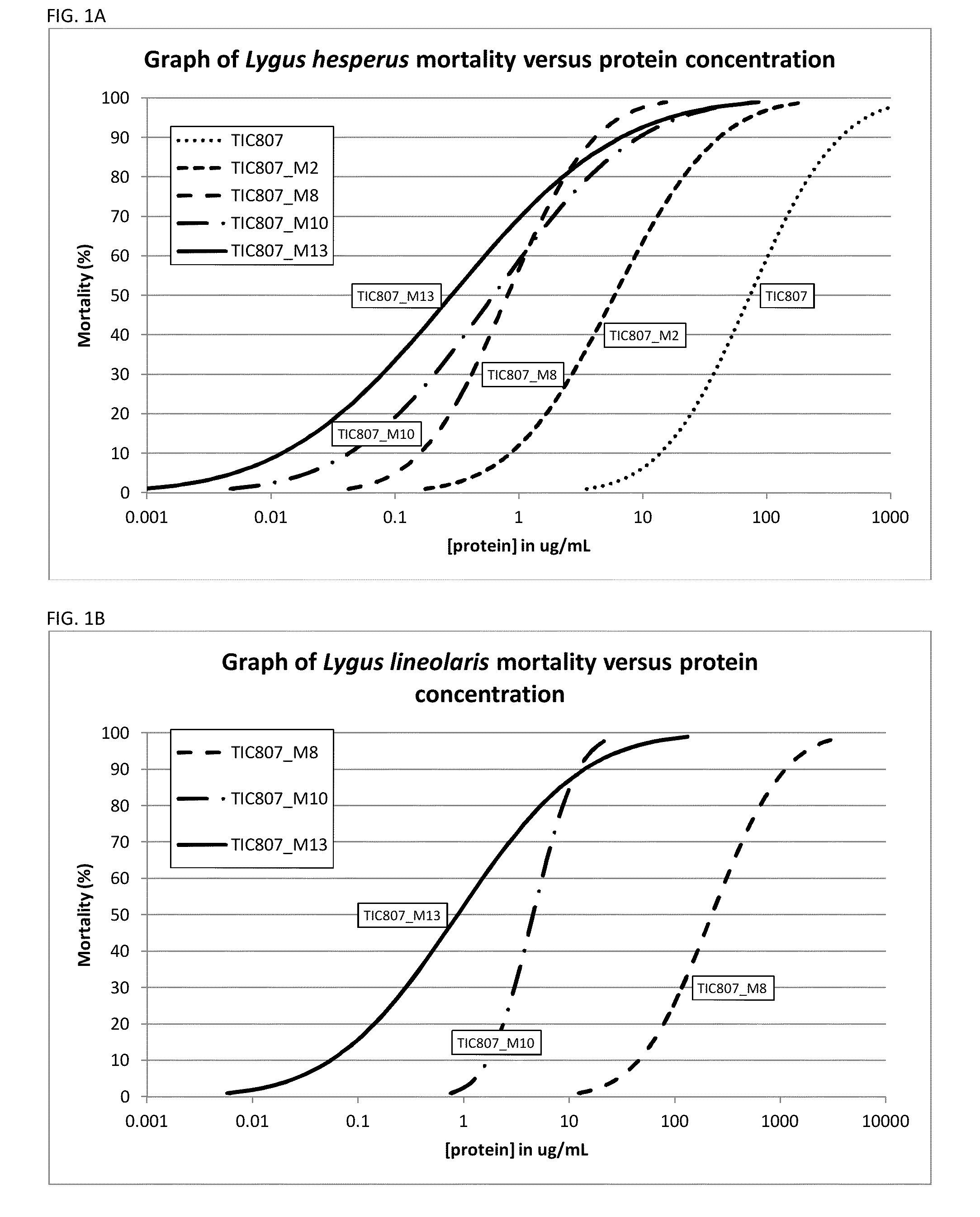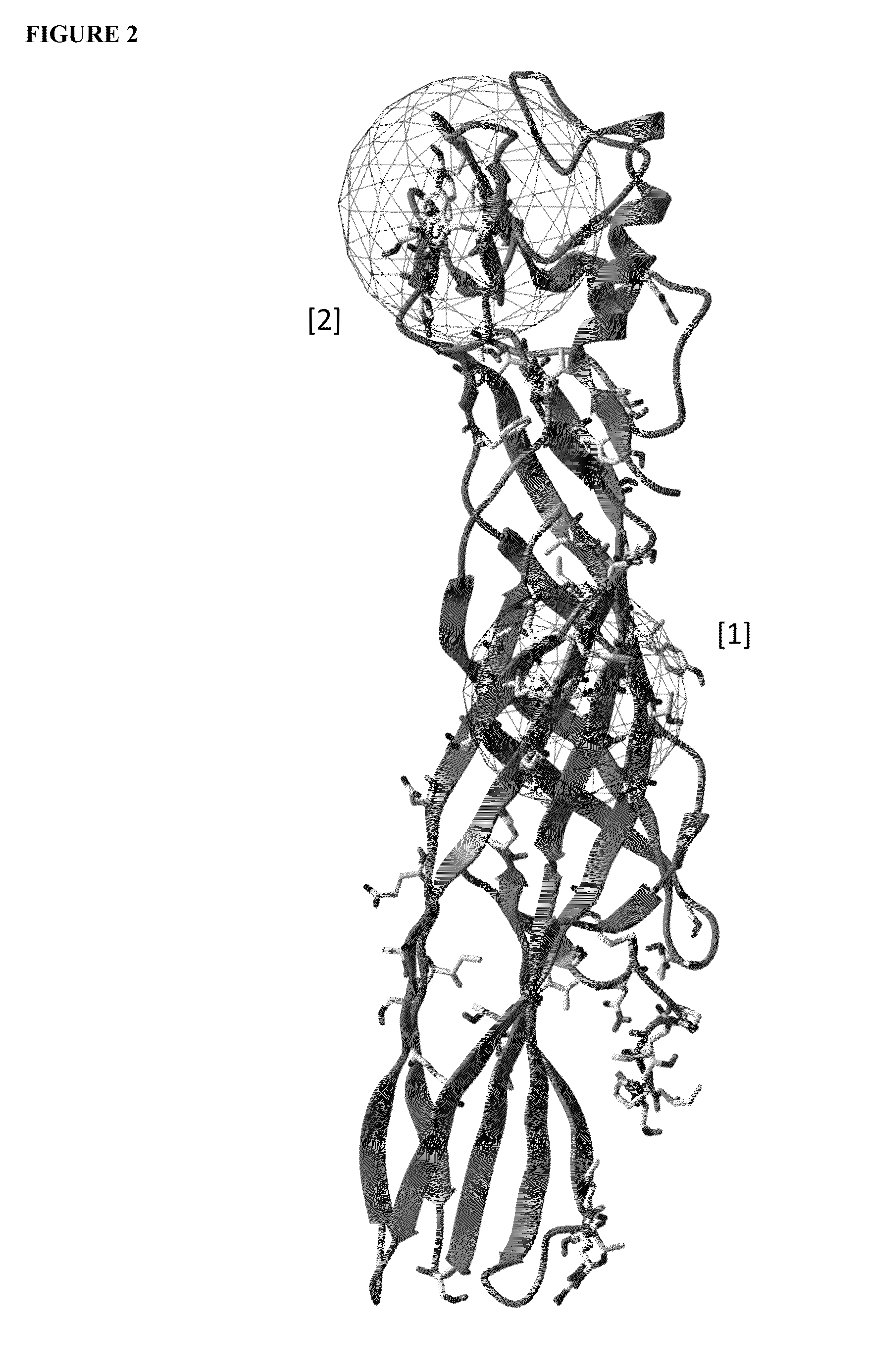Proteins Toxic To Hemipteran Insect Species
a technology of insect species and proteins, applied in the field of insect inhibitory proteins, can solve the problems that no bt proteins have been developed for commercial control of hemipteran pest species, and achieve the effect of low or virtually undetectable toxic effects
- Summary
- Abstract
- Description
- Claims
- Application Information
AI Technical Summary
Benefits of technology
Problems solved by technology
Method used
Image
Examples
example 1
Iterative Engineering-Testing-Selecting Approach
[0075]This example illustrates the random, combinatorial, and inventive aspects of the iterative (also can be referred to as “recursive”) engineering-testing-selecting approach used to identify and describe insect inhibitory proteins exhibiting Coleopteran and / or nematicidal activity or increased toxicity to Hemipteran insect species compared to TIC807 (SEQ ID NO:2). Several design approaches were employed to engineer for eHTP's with greater inhibitory activity against Lygus species; approaches that included but were not limited to semi-random modifications, directed modifications of variances in an alignment of TIC807 with other native Bt proteins, and structure / function assisted design. Numerous rounds of engineering and testing were conducted (both consecutively and concurrently) to select for TIC807 protein variants exhibiting increased toxicity. Design approaches were adjusted as data was collected. This iterative engineering-test...
example 2
Engineering Approaches
Alignment Based Approaches
[0079]A multiple sequence alignment of protein members of Cry51: Cry51Aa1 (SEQ ID NO:182), TIC853 (SEQ ID NO:184), and TIC807 (SEQ ID NO:2) were used to identify regions of variability, e.g., positions 195 to 201 and positions 211 to 219, relative to SEQ ID NO:2 (TIC807). These regions were targeted for saturation mutagenesis through use of degenerate oligonucleotide primers encoding random amino acid residues in these regions. Construct libraries were prepared for subsequent protein expression in host cells.
[0080]A multiple sequence alignment of Cry51Aa1 (SEQ ID NO:182), TIC853 (SEQ ID NO:184), and TIC807 (SEQ ID NO:2) was used in combination with a BLOSUM 80 substitution matrix to calculate average pair-wise distances for each position variant to TIC807. Residue positions with lower average pair-wise distances were substituted with alternative amino acid residues using degenerate oligonucleotide primers encoding for alternative amino...
example 3
Protein Expression and Purification of TIC807, Including Variants and Fragments
[0093]Control protein TIC807 is a protein of 309 amino acids in length that can be expressed in crystalline form in Bacillus thuringiensis (Bt) or aggregate form in E. coli. Test variants thereof were recombinantly expressed in Bt. An expression characteristic of TIC807 and variants of TIC807 is the predominant crystalline and aggregate forms extracted from Bt and E. coli cells, respectively. To test for Lygus bioactivity, test and control samples were made suitable for Lygus bioassay by solubilizing samples in 25 mM Sodium Carbonate buffer and removing unsolubilized materials by centrifugation. The amount of protein in test and control samples were measured using total protein methods, e.g.s, a Bradford assay, an ELISA method, or similar. Gel electrophoresis was used to determine the purity and stock concentration of the solubilized recombinant protein. C-terminal HIS-tagged TIC807 protein was engineered...
PUM
| Property | Measurement | Unit |
|---|---|---|
| Fraction | aaaaa | aaaaa |
| Fraction | aaaaa | aaaaa |
| Inhibition | aaaaa | aaaaa |
Abstract
Description
Claims
Application Information
 Login to View More
Login to View More - R&D
- Intellectual Property
- Life Sciences
- Materials
- Tech Scout
- Unparalleled Data Quality
- Higher Quality Content
- 60% Fewer Hallucinations
Browse by: Latest US Patents, China's latest patents, Technical Efficacy Thesaurus, Application Domain, Technology Topic, Popular Technical Reports.
© 2025 PatSnap. All rights reserved.Legal|Privacy policy|Modern Slavery Act Transparency Statement|Sitemap|About US| Contact US: help@patsnap.com



